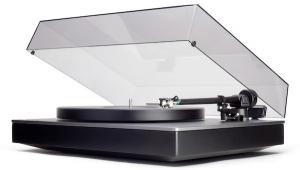SME 10 turntable Page 3
Speed accuracy was not spot on but was very, very close: one strobe bar per revolution fast, which translates to one extra revolution every nine minutes. In terms of absolute pitch, this is a non-issue. I played a test LP containing a 440Hz tone (concert A) and, using my guitar tuner, got 441Hz. Was the lathe used to cut the LP running precisely on speed? Who knows?
I had a chance to speak with SME's Alastair Robertson-Aikman about this. He told me that in current production of the Model 10 the speed discrepancy is down to half a strobe bar per revolution, and that, given the 40:1 ratio between pulley and subplatter, a variance in pulley diameter of only a few microns can affect the speed. He also told me that he prefers the tolerance limits to be on the plus side to compensate for stylus drag. SME can provide additional pulleys for owners who wish to edge even closer to perfection.
Looks small, sounds BIG
My sonic prediction for a plinthless, suspensionless, nonacrylic turntable was that it would sound something like the Simon Yorke Series 7 that I reviewed in June 1998, and in many ways the SME did. These densely packed, suspensionless designs tend to grab me first with their rhythmic confidence; the SME did not disappoint.
I began with the Transfiguration Temper Supreme, about as neutral a cartridge as I know of. While I also ran the Model 10 with the Lyra Parnassus D.C.t, the EMT TU-3 Geyger, and the Lyra Evolve 99, with the Temper Supreme the verdict was in within a few slabs of wax: The dynamic performance the 10 yanked from the Temper Supreme was startlingly better than I was accustomed to.
Rhythmically and dynamically, the Model 10's performance with the M10 arm was dramatic and exciting. That was the first aspect of the system's performance I noticed. The pacing and rhythmic organization of familiar music—the sense that musical events were occurring right on time—created a sensation of emotional trust between me and the 'table.
While some turntables can induce relaxation in the listener because they tend toward the soft, lush, and easy, the 10 relaxed me for the opposite reason: I quickly became confident that the rock-solid SME was going to easily handle the big musical bumps in the road that cause some 'tables to falter.
On the Small Faces' Ogdens' Nut Gone Flake there's a really fun track called "Lazy Sunday Afternoon"; it features a sustained, extremely deep electric bass note that only a few 'tables can really hit and hold. The SME is one of them. While my experience with an SME V arm on a SOTA Cosmos many years ago led me to believe that the V has slightly plummy, exaggerated bass, I didn't find that to be the case with the 10/M10 combo. Bass dynamics, bass clarity, and especially control were outstanding—both on loud explosive notes like those found on the 45rpm edition of Public Image Ltd.'s Metal Box, and on more subtle recordings of acoustic bass like Rob Wasserman's Duets.
Another area in which the 10 excelled was transient response. Cymbals and sibilants were reproduced with an impressive combination of clarity, speed, and weight. Piano, which contains a wicked combination of percussion (felt hammers on wire strings tensioned on a metal frame), rich harmonic overtones (wooden sounding board), reverberant trails (pedal sustain and room sound), and an unusually wide fundamental bandwidth, was particularly well served by the 10—about as convincingly as I've heard the instrument reproduced by a turntable.
The overall tonal balance of the 10/M10 was slightly dry overall, and a bit lean and less rich in both the midbass and midrange compared to my reference Simon Yorke with its integral arm, or with either the Graham 2.0 or Immedia RPM2 arms. One has to be very careful about ascribing tonal colorations to a turntable, given that it works only in association with a transducer (the cartridge), the second most colored item in the chain—the first being the loudspeaker, which interacts not with a piece of vinyl, but with a room. Talking about turntable colorations is kind of like trying to measure a fart in a hurricane.
- Log in or register to post comments




















































